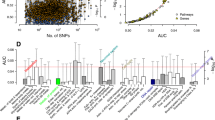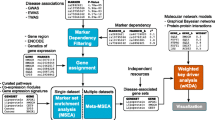Abstract
The metabolic syndrome (MS) constitutes a combination of underlying risk factors for an adverse outcome, cardiovascular disease. Thus, the clinical behavior of the MS can be regarded as a whole. Nevertheless, from a pathogenic point of view, understanding of the underlying mechanisms of each MS intermediate phenotype is far beyond their understanding as an integrative process. Systems biology introduces a new concept for revealing the pathogenesis of human disorders and suggests the presence of common physiologic processes and molecular networks influencing the risk of a disease. This paper shows a model of this concept to explain the genetic determinants of MS-associated phenotypes. Based on the hypothesis that common physiologic processes and molecular networks may influence the risk of MS disease components, we propose two systems-biology approaches: a gene enrichment analysis and the use of a protein-protein interaction network. Our results show that a network driven by many members of the nuclear receptor superfamily of proteins, including retinoid X receptor and farnesoid X receptor (FXR), may be implicated in the pathogenesis of the MS by its interactions at multiple levels of complexity with genes associated with metabolism, cell differentiation, and oxidative stress. In addition, we review two alternative genetic mechanisms that are gaining acceptance in the physiopathology of the MS: the regulation of transcriptional and post-transcriptional gene expression by microRNAs and epigenetic modifications such as DNA methylation.

Similar content being viewed by others
References
Papers of particular interest, published recently, have been highlighted as: • Of importance
Despres JP, Lemieux I: Abdominal obesity and metabolic syndrome. Nature 2006, 444:881–887.
Kahn R: Metabolic syndrome: is it a syndrome? Does it matter? Circulation 2007, 115:1806–1810.
Alberti KG, Zimmet PZ: Definition, diagnosis and classification of diabetes mellitus and its complications. Part 1: diagnosis and classification of diabetes mellitus provisional report of a WHO consultation. Diabet Med 1998, 15:539–553.
Executive Summary of The Third Report of The National Cholesterol Education Program (NCEP) Expert Panel on Detection, Evaluation, And Treatment of High Blood Cholesterol In Adults (Adult Treatment Panel III). JAMA 2001, 285:2486–2497.
Alberti KG, Zimmet P, Shaw J: The metabolic syndrome—a new worldwide definition. Lancet 2005, 366:1059–1062.
Sookoian S, Pirola CJ: Genetics of the cardiometabolic syndrome: new insights and therapeutic implications. Ther Adv Cardiovasc Dis 2007, 1:37–47.
Zhang C: Novel functions for small RNA molecules. Curr Opin Mol Ther 2009, 11:641–651.
Weaver IC: Epigenetic programming by maternal behavior and pharmacological intervention. Nature versus nurture: let’s call the whole thing off. Epigenetics 2007, 2:22–28.
• Chen J, Bardes EE, Aronow BJ, et al.: ToppGene Suite for gene list enrichment analysis and candidate gene prioritization. Nucleic Acids Res 2009, 37:W305–W311. This article demonstrates the bioinformatic tool for gene list functional enrichment, candidate gene prioritization, and identification and prioritization of novel disease candidate genes in the interactome.
Sookoian S, Gianotti TF, Schuman M, et al.: Gene prioritization based on biological plausibility over genome wide association studies renders new loci associated with type 2 diabetes. Genet Med 2009, 11:338–343.
Sookoian S, Gemma C, Pirola CJ: Influence of hepatocyte nuclear factor 4α (HNF4α) gene variants on the risk of type 2 diabetes: a meta-analysis in 49,577 individuals. Mol Genet Metab 2010, 99:80–89.
Sookoian S, Gianotti TF, Gemma C, et al.: Role of genetic variation in insulin-like growth factor 1 receptor on insulin resistance and arterial hypertension. J Hypertens 2010, 28:1194–1202.
Hindorff LA, Sethupathy P, Junkins HA, et al.: Potential etiologic and functional implications of genome-wide association loci for human diseases and traits. Proc Natl Acad Sci U S A 2009, 106:9362–9367.
Sookoian S, Gemma C, Garcia SI, et al.: Short allele of serotonin transporter gene promoter is a risk factor for obesity in adolescents. Obesity (Silver Spring) 2007, 15:271–276.
Sookoian S, Gianotti TF, Gemma C, et al.: Contribution of the functional 5-HTTLPR variant of the SLC6A4 gene to obesity risk in male adults. Obesity (Silver Spring) 2008, 16:488–491.
Duez H, Staels B: Nuclear receptors linking circadian rhythms and cardiometabolic control. Arterioscler Thromb Vasc Biol 2010, 30:1529–1534.
Sookoian S, Gemma C, Gianotti TF, et al.: Genetic variants of Clock transcription factor are associated with individual susceptibility to obesity. Am J Clin Nutr 2008, 87:1606–1615.
Sookoian S, Castano G, Gemma C, et al.: Common genetic variations in CLOCK transcription factor are associated with nonalcoholic fatty liver disease. World J Gastroenterol 2007, 13:4242–4248.
Li S, Zhao JH, Luan J, et al.: Cumulative effects and predictive value of common obesity-susceptibility variants identified by genome-wide association studies. Am J Clin Nutr 2010, 91:184–190.
Tomaszewski M, Charchar FJ, Lacka B, et al.: Epistatic interaction between β2-adrenergic receptor and neuropeptide Y genes influences LDL-cholesterol in hypertension. Hypertension 2004, 44:689–694.
Baessler A, Fischer M, Mayer B, et al.: Epistatic interaction between haplotypes of the ghrelin ligand and receptor genes influence susceptibility to myocardial infarction and coronary artery disease. Hum Mol Genet 2007, 16:887–899.
Isaacs A, Aulchenko YS, Hofman A, et al.: Epistatic effect of cholesteryl ester transfer protein and hepatic lipase on serum high-density lipoprotein cholesterol levels. J Clin Endocrinol Metab 2007, 92:2680–2687.
Brisson D, St-Pierre J, Santure M, et al.: Genetic epistasis in the VLDL catabolic pathway is associated with deleterious variations on triglyceridemia in obese subjects. Int J Obes (Lond) 2007, 31:1325–1333.
Sookoian S, Gianotti TF, Burgueño A, Pirola CJ: Gene-gene interaction between serotonin transporter (SLC6A4) and CLOCK modulates the risk of metabolic syndrome in rotating shiftworkers. Chronobiol Int 2010, 27:1202–1218.
Ling C, Del Guerra S, Lupi R, et al.: Epigenetic regulation of PPARGC1A in human type 2 diabetic islets and effect on insulin secretion. Diabetologia 2008, 51:615–622.
Gemma C, Sookoian S, Alvarinas J, et al.: Maternal pregestational BMI is associated with methylation of the PPARGC1A promoter in newborns. Obesity (Silver Spring) 2009, 17:1032–1039.
Gemma C, Sookoian S, Dieuzeide G, et al.: Methylation of TFAM gene promoter in peripheral white blood cells is associated with insulin resistance in adolescents. Mol Genet Metab 2010, 100:83–87.
Gemma C, Sookoian S, Alvarinas J, et al.: Mitochondrial DNA depletion in small- and large-for-gestational-age newborns. Obesity (Silver Spring) 2006, 14:2193–2199.
Gianotti TF, Sookoian S, Dieuzeide G, et al.: A decreased mitochondrial DNA content is related to insulin resistance in adolescents. Obesity 2008, 16:1591–1595.
Ling C, Groop L: Epigenetics: a molecular link between environmental factors and type 2 diabetes. Diabetes 2009, 58:2718–2725.
Sethupathy P, Borel C, Gagnebin M, et al.: Human microRNA-155 on chromosome 21 differentially interacts with its polymorphic target in the AGTR1 3′ untranslated region: a mechanism for functional single-nucleotide polymorphisms related to phenotypes. Am J Hum Genet 2007, 81:405–413.
Sookoian S, Castano G, Garcia SI, et al.: A1166C angiotensin II type 1 receptor gene polymorphism may predict hemodynamic response to losartan in patients with cirrhosis and portal hypertension. Am J Gastroenterol 2005, 100:636–642.
Yang Z, Kaye DM: Mechanistic insights into the link between a polymorphism of the 3′UTR of the SLC7A1 gene and hypertension. Hum Mutat 2009, 30:328–333.
Yang Z, Venardos K, Jones E, et al.: Identification of a novel polymorphism in the 3′UTR of the L-arginine transporter gene SLC7A1: contribution to hypertension and endothelial dysfunction. Circulation 2007, 115:1269–1274.
• Rayner KJ, Suarez Y, Davalos A, et al.: MiR-33 contributes to the regulation of cholesterol homeostasis. Science 2010, 328:1570–1573. The authors demonstrated that miR-33 appears to regulate both HDL biogenesis in the liver and cellular cholesterol efflux.
Peter ME: Targeting of mRNAs by multiple miRNAs: the next step. Oncogene 2010, 29:2161–2164.
Warde-Farley D, Donaldson SL, Comes O, et al: The GeneMANIA prediction server: biological network integration for gene prioritization and predicting gene function. Nucleic Acids Res. 2010:W214-220.
Acknowledgments
Supported in part by Grants UBACYT M055 (Universidad de Buenos Aires) and PICT 2006-124 (Agencia Nacional de Promoción Científica y Tecnológica). SS and CJP are members of Consejo Nacional de Investigaciones Científicas (CONICET).
Disclosure
No potential conflicts of interest relevant to this article were reported.
Author information
Authors and Affiliations
Corresponding author
Rights and permissions
About this article
Cite this article
Sookoian, S., Pirola, C.J. Metabolic Syndrome: From the Genetics to the Pathophysiology. Curr Hypertens Rep 13, 149–157 (2011). https://doi.org/10.1007/s11906-010-0164-9
Published:
Issue Date:
DOI: https://doi.org/10.1007/s11906-010-0164-9




